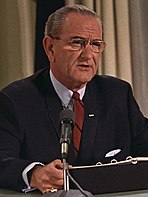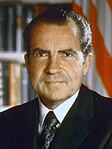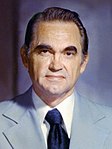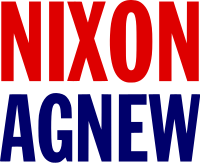
A | B | C | D | E | F | G | H | CH | I | J | K | L | M | N | O | P | Q | R | S | T | U | V | W | X | Y | Z | 0 | 1 | 2 | 3 | 4 | 5 | 6 | 7 | 8 | 9
| |||||||||||||||||||||||||||||||||||||
538 members of the Electoral College 270 electoral votes needed to win | |||||||||||||||||||||||||||||||||||||
|---|---|---|---|---|---|---|---|---|---|---|---|---|---|---|---|---|---|---|---|---|---|---|---|---|---|---|---|---|---|---|---|---|---|---|---|---|---|
| Opinion polls | |||||||||||||||||||||||||||||||||||||
| Turnout | 62.5%[1] | ||||||||||||||||||||||||||||||||||||
| |||||||||||||||||||||||||||||||||||||
 Presidential election results map. Red denotes states won by Nixon/Agnew, blue denotes those won by Humphrey/Muskie, and orange denotes those won by Wallace/LeMay, including a North Carolina faithless elector. Numbers indicate electoral votes cast by each state. | |||||||||||||||||||||||||||||||||||||
| |||||||||||||||||||||||||||||||||||||

The 1968 United States presidential election was the 46th quadrennial presidential election, held on Tuesday, November 5, 1968. The Republican nominee, former vice president Richard Nixon, defeated both the Democratic nominee, incumbent vice president Hubert Humphrey, and the American Independent Party nominee, former Alabama governor George Wallace. This was the last election until 1988 in which the incumbent president was not on the ballot. This is the most recent election where a third-party candidate won a state.
Incumbent president Lyndon B. Johnson had been the early front-runner for the Democratic Party's nomination, but he withdrew from the race after only narrowly winning the New Hampshire primary. Eugene McCarthy, Robert F. Kennedy and Humphrey emerged as the three major candidates in the Democratic primaries until Kennedy was assassinated. His death after midnight on June 6, 1968, continued a streak of high-profile assassinations in the 1960s. Humphrey edged out anti-Vietnam war candidate McCarthy to win the Democratic nomination, sparking numerous anti-war protests. Nixon entered the Republican primaries as the front-runner, defeating liberal New York governor Nelson Rockefeller, conservative governor of California Ronald Reagan, and other candidates to win his party's nomination. Alabama's Democratic former governor, George Wallace, ran on the American Independent Party ticket, campaigning in favor of racial segregation on the basis of "states’ rights". The election year was tumultuous and chaotic. It was marked by the assassination of Martin Luther King Jr. in early April, and the subsequent 54 days of riots across the nation, by the assassination of Robert F. Kennedy in early June, and by widespread opposition to the Vietnam War across university campuses. Vice President Hubert Humphrey won and secured the Democratic nomination, with Humphrey promising to continue Johnson's war on poverty and to support the civil rights movement.
The support of civil rights by the Johnson administration hurt Humphrey's image in the South, leading the prominent Democratic governor of Alabama, George Wallace, to mount a third-party challenge against his own party to defend racial segregation on the basis of "states’ rights". Wallace led a far-right American Independent Party attracting socially conservative voters throughout the South, and encroaching further support from white working-class voters in the Industrial North and Midwest who were attracted to Wallace's economic populism and anti-establishment rhetoric. In doing so, Wallace split the New Deal Coalition, winning over Southern Democrats, as well as former Goldwater supporters who preferred Wallace to Nixon. Nixon chose to take advantage of Democratic infighting by running a more centrist platform aimed at attracting moderate voters as part of his "silent majority" who were alienated by both the liberal agenda that was advocated by Hubert Humphrey and by the ultra-conservative viewpoints of George Wallace on race and civil rights. However, Nixon also employed coded language to combat Wallace in the Upper South, where the electorate was less extreme on the segregation issue. Nixon sought to restore law and order to the nation's cities and provide new leadership in the Vietnam War.
During most of the campaign, Humphrey trailed Nixon significantly in polls taken from late August to early October, with some polls predicting a margin of victory of as high as 16% as late as August. In the final month of the campaign, however, Humphrey managed to narrow Nixon's lead after Wallace's candidacy collapsed and Johnson suspended bombing in the Vietnam War to appease the anti-war movement; the election was considered a tossup by election day. Nixon managed to secure a close victory in the popular vote on election day, with just over 500,000 votes (0.7%) separating him and Humphrey. In the electoral college, however, Nixon's victory was much larger; he carried the tipping point state of California by over 230,000 votes (3.08%), and his overall margin of victory in the electoral college was 110 votes. This was the first presidential election after the passage of the Voting Rights Act of 1965 which had resulted in growing restoration of the franchise for racial minorities, especially in the South, where most had been disenfranchised since the turn of the century. Minorities in other areas also regained their ability to vote.[2]
Nixon also became the first non-incumbent vice president to be elected president, something that would not happen again until 2020, when Joe Biden was elected president.[3] This also remains the most recent election in which the incumbent president was eligible to run again but was not the eventual nominee of that person's party. Nixon's victory also commenced the Republican Party's lock on certain Western states that would vote for them in every election until 1988, allowing them to win the presidency in five of the six presidential elections that took place in that period.
Background
In the election of 1964, incumbent Democratic U.S. president Lyndon B. Johnson won the largest popular vote landslide in U.S. presidential election history over Republican U.S. Senator Barry Goldwater. During the presidential term that followed, Johnson was able to achieve many political successes, including passage of his Great Society domestic programs (including "War on Poverty" legislation), landmark civil rights legislation, and the continued exploration of space. Despite these significant achievements, Johnson's popular support would be short-lived. Even as Johnson scored legislative victories, the country endured large-scale race riots in the streets of its larger cities, along with a generational revolt of young people and violent debates over foreign policy. The emergence of the hippie counter-culture, the rise of New Left activism, and the emergence of the Black Power movement exacerbated social and cultural clashes between classes, generations, and races. Adding to the national crisis, on April 4, 1968, civil rights leader Rev. Martin Luther King Jr., was assassinated in Memphis, Tennessee, igniting riots of grief and anger across the country. In Washington, D.C., rioting took place within a few blocks of the White House, and the government stationed soldiers with machine guns on the Capitol steps to protect it.[4][5]
The Vietnam War was the primary reason for the precipitous decline of President Johnson's popularity. He had escalated U.S. commitment so by late 1967 over 500,000 American soldiers were fighting in Vietnam. Draftees made up 42 percent of the military in Vietnam, but suffered 58% of the casualties, as nearly 1000 Americans a month were killed, and many more were injured.[6] But resistance to the war rose as success seemed ever out of reach. The national news media began to focus on the high costs and ambiguous results of escalation, despite Johnson's repeated efforts to downplay the seriousness of the situation.
In early January 1968, Secretary of Defense Robert McNamara said the war would be winding down, claiming that the North Vietnamese were losing their will to fight. But, shortly thereafter, the North Vietnamese launched the Tet Offensive, in which they and Communist forces of Vietcong undertook simultaneous attacks on all government strongholds across South Vietnam. Though the uprising ended in a U.S. military victory, the scale of the Tet offensive led many Americans to question whether the war could be "won", or was worth the costs to the U.S. In addition, voters began to mistrust the government's assessment and reporting of the war effort. The Pentagon called for sending several hundred thousand more soldiers to Vietnam. Johnson's approval ratings fell below 35%. The Secret Service refused to let the president visit American colleges and universities, and prevented him from appearing at the 1968 Democratic National Convention in Chicago, because it could not guarantee his safety.[7]
Republican Party nomination
| ||
|---|---|---|
|
Pre-vice presidency 36th Vice President of the United States Post-vice presidency 37th President of the United States
Judicial appointments
Policies
First term
Second term
Post-presidency Presidential campaigns Vice presidential campaigns
 |
||








